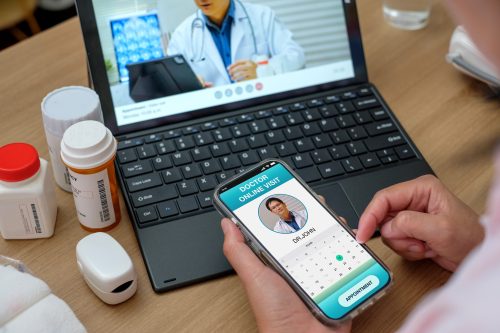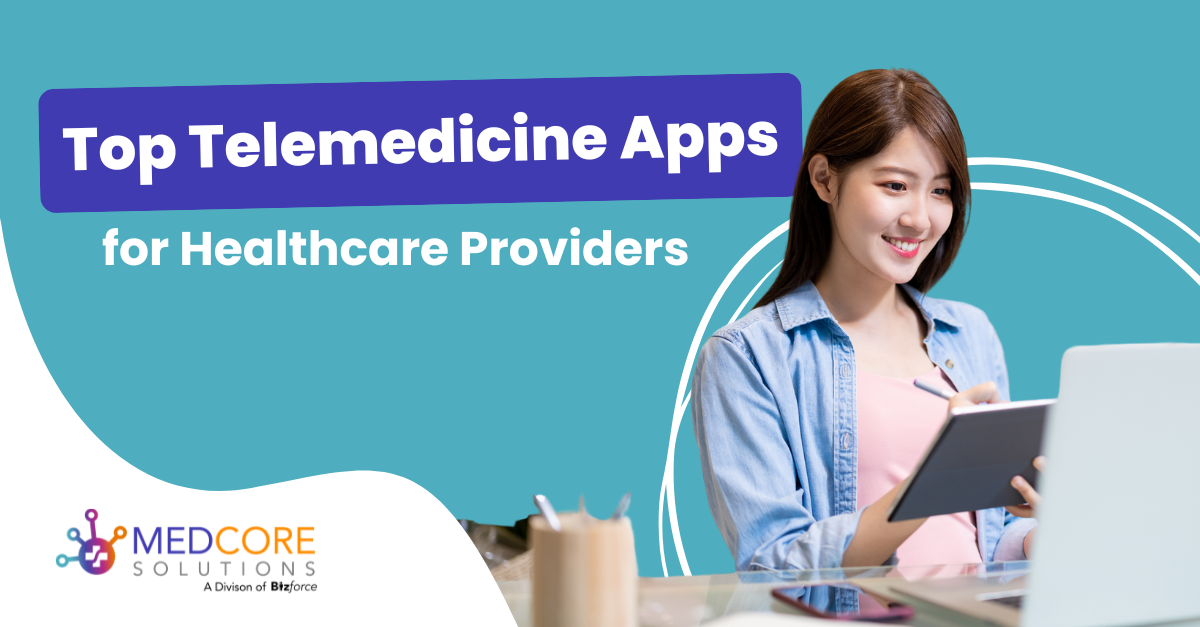
As per Fortune Business Insights, significant expansion is anticipated in the telehealth sector, with forecasts suggesting a rise from $142.96 billion in 2023 to $504.24 billion by 2030. Furthermore, with this expansion comes the emergence of telemedicine apps which have become essential tools for healthcare providers. They offer an easy and effective way to connect with patients. Furthermore, they deliver care remotely and streamline practice operations easily. From virtual consultations to secure messaging platforms, these apps empower providers to deliver high-quality care anytime, anywhere. In this blog, we’ll explore some of the best telemedicine apps available for healthcare providers, pointing out their key features and benefits.
Top Telemedicine Apps for Healthcare Providers

-
Doxy.me
Doxy.me is a simple and easy-to-use HIPAA-compliant telemedicine platform. It is designed to facilitate virtual appointments between healthcare providers and patients. With Doxy.me, providers can conduct secure video consultations. Moreover, this app allows document and image sharing. It also allows providers to collect payments online. Additionally, its customizable waiting rooms make it easy to maintain professionalism and privacy. Doxy.me also integrates with electronic health record (EHR) systems for easy documentation and ongoing care.
-
Amwell
Amwell is also one of the telemedicine apps that offers an easy-to-use interface and robust features for healthcare providers. With Amwell, providers can conduct virtual visits with patients via video or phone too. Moreover, this app allows healthcare providers to review medical histories and test results and prescribe medications electronically. The platform offers integration with EHR systems too. Amwell is available as a mobile app for iOS and Android devices, making it easy for providers to connect with patients on the go.
-
Updox
Updox is a comprehensive telehealth platform that offers a wide range of features for healthcare providers. Its features include video consultations, secure chatting, and electronic faxing. With Updox, providers can conduct virtual visits with patients, share documents and images securely, and communicate with other members of the care team in real time. Easy documentation is also offered by the platform with its EHR system integration option.
-
Kareo Telemedicine
Kareo Telemedicine is a telehealth platform designed specifically for small to medium-sized practices. With Kareo Telemedicine, providers can conduct virtual visits with patients via video, review medical histories and test results, and prescribe medications electronically. The platform also offers integration with Kareo’s suite of practice management and EHR solutions. Therefore, easy documentation and billing are still in the picture with Kareo. Moreover, Kareo Telemedicine is available as a separate platform or as part of the Kareo Complete EHR package.
-
Zoom for Healthcare
Zoom for Healthcare is a telemedicine platform that offers secure video conferencing solutions for healthcare providers. With Zoom for Healthcare, providers can conduct virtual visits with patients via high-definition video. They can also share documents and images securely. Zoom is indeed one of the best tools for working together with other members of the care team in real time. Additionally, the platform is HIPAA-compliant and offers end-to-end encryption. Therefore, the security and privacy of patient information are ensured. Zoom for Healthcare is available as a separate platform or as part of the Zoom Meetings suite of products.
Why Telemedicine Apps Will Boost Your ROI and Increase Patient Retention
The Convenience Factor
One of the primary drivers behind the popularity of telemedicine apps is convenience. With busy schedules and long commutes becoming the norm for many people, the ability to consult with a healthcare provider from the comfort of home or on the go is a game-changer. Telemedicine apps eliminate the need for travel and waiting room time. Therefore, patients can connect with a doctor at a time and place that suits them best.
Access to Specialists
Another significant benefit of telemedicine apps is the ability for specialists to be reached by patients regardless of geographical location. There are rural areas where care may be limited. Nevertheless, telemedicine is here to break down these barriers. Patients can now connect with experts from around the world. Whether it’s a dermatologist, psychiatrist, or oncologist, telemedicine apps ensure that patients can receive the care they need without having to travel long distances.
Continuity of Care
Furthermore, telemedicine apps also promote ongoing care by allowing patients to stay connected with their healthcare providers between in-person visits. Whether it’s following up on a treatment plan, managing chronic conditions, or addressing minor health concerns, telemedicine apps facilitate ongoing communication between patients and providers, leading to better health outcomes in the long run.
Cost Savings

The expense of healthcare often acts as a major obstacle for many providers wanting patient retention. However, telemedicine apps offer a more affordable alternative to traditional in-person visits. With lower consultation fees and reduced out-of-pocket expenses, they alleviate financial burdens. By eliminating the need for travel and reducing overhead costs associated with brick-and-mortar clinics, telemedicine apps help make healthcare more accessible and cost-effective for patients. This contributes to effective RCM.
Improved Patient Experience
Beyond ease and cost savings, telemedicine apps also enhance the overall patient experience. With easy-to-use interfaces and intuitive features, these apps make it easy for patients to schedule appointments, communicate with providers, and access medical records securely. Additionally, the ability to choose from a diverse pool of healthcare professionals gives patients greater control over their care, empowering them to find a provider who meets their specific needs and preferences.
Addressing Barriers to Adoption
While telemedicine apps offer numerous benefits, widespread adoption still faces some barriers. One of the main challenges is ensuring equitable access to technology, particularly among underserved populations who may lack reliable internet connections or smartphones. Therefore, telemedicine providers must work to expand access through initiatives such as subsidized devices or partnerships with community organizations.
Additionally, concerns about data privacy and security remain a top priority for both patients and healthcare providers. Telemedicine companies must prioritize robust encryption protocols and compliance with regulatory standards to safeguard sensitive patient information and maintain trust in their platforms.
Conclusion
Telemedicine apps have changed the way healthcare providers deliver care, offering a convenient and effective alternative to traditional in-person visits. Whether it’s conducting virtual consultations, prescribing medications electronically, or working together with other members of the care team, these apps empower providers to deliver high-quality care anytime, anywhere. By leveraging the latest technology, telemedicine apps are helping to improve access to healthcare, enhance patient outcomes, and streamline practice operations. As the healthcare landscape continues to evolve, telemedicine apps will play an increasingly important role in shaping the future of healthcare delivery.
Experience the next level of telemedicine expertise with MedCore! Elevate your practice with our team of seasoned telemedicine professionals. Partner with us to access top-notch expertise and deliver exceptional virtual care. Contact us here.

